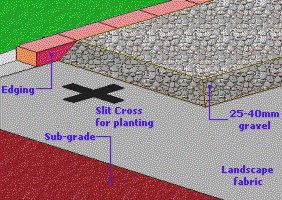 |
 |
 |
 |
 |
 |
 |
 |
 |
 |
 |
 |
 |
 |
 |
 |
 |
 |
 |
| | If you have any feedback on how we can make our new website better please do contact us. We would like to hear from you.
| |
|
|
 |
 |
|
 |
 |
Gravel can be a quick way to transform a patch of your garden, but it needs to be laid properly. Here are our tips on getting the job done right. TOP TIPS FOR LAYING GRAVEL- Before you begin, mark out the area you want to fill using pegs and lines
- Keep the edge of the area high to stop the gravel spilling out.
- Use something flexible, like a piece of rope, to mark out curved edges.
Laying gravel in the garden is a cheap way to transform an outdoor space and it provides instant results. However, it can end up all over the place, getting caught in the tread of your boots and is hard to keep clean of fallen leaves. Careful preparation is therefore essential to getting it right in your garden.
Consider the size
Consider what the proposed area is to be used for and choose the gravel size accordingly. Really small gravel tends to be too fine for areas that will have to cope with lots of foot traffic, as it will spread too easily. However, larger gravel pieces can be uncomfortable underfoot. if you need a bit more advice before getting started just please call.
Make a gravel pathway
There are a couple of ways of going about preparing an area for gravel. If the space is to be used as a seating area or pathway, it is a good idea to dig down about 10cm and lay a compacted layer of hardcore - then lay 3-4 inches of gravel on top. This is important to avoid the gravel sinking or becoming unstable underfoot when wet.
Use gravel decoratively
If the area is to be mainly decorative, then you can simply dig away the surface and lay a weed suppressing membrane. Peg it down and chuck the gravel on to
p. You can plant through this by cutting across the membrane.
Contain the gravel
 Finally, you will need to decide how to keep the gravel in around the edges. Timber edging is quick, easy and cheap to install, but can be difficult if you want to have curves. Bricks and larger cobbles offer a more permanent alternative and can be set in concrete. The end result is also far more appealing visually. Finally, you will need to decide how to keep the gravel in around the edges. Timber edging is quick, easy and cheap to install, but can be difficult if you want to have curves. Bricks and larger cobbles offer a more permanent alternative and can be set in concrete. The end result is also far more appealing visually.
|
 |
| |
 |
|




 Finally, you will need to decide how to keep the gravel in around the edges. Timber edging is quick, easy and cheap to install, but can be difficult if you want to have curves. Bricks and larger cobbles offer a more permanent alternative and can be set in concrete. The end result is also far more appealing visually.
Finally, you will need to decide how to keep the gravel in around the edges. Timber edging is quick, easy and cheap to install, but can be difficult if you want to have curves. Bricks and larger cobbles offer a more permanent alternative and can be set in concrete. The end result is also far more appealing visually.
